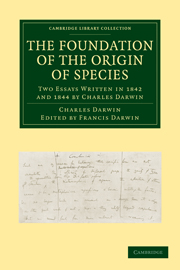Book contents
- Frontmatter
- Contents
- INTRODUCTION
- PART I
- PART II
- PART I
- PART II ON THE EVIDENCE FAVOURABLE AND OPPOSED TO THE VIEW THAT SPECIES ARE NATURALLY FORMED RACES, DESCENDED FROM COMMON STOCKS
- CHAPTER IV ON THE NUMBER OF INTERMEDIATE FORMS REQUIRED ON THE THEORY OF COMMON DESCENT; AND ON THEIR ABSENCE IN A FOSSIL STATE
- CHAPTER V GRADUAL APPEARANCE AND DISAPPEARANCE OF SPECIES
- CHAPTER VI ON THE GEOGRAPHICAL DISTRIBUTION OF ORGANIC BEINGS IN PAST AND PRESENT TIMES
- CHAPTER VII ON THE NATURE OF THE AFFINITIES AND CLASSIFICATION OF ORGANIC BEINGS
- CHAPTER VIII UNITY OF TYPE IN THE GREAT CLASSES; AND MORPHOLOGICAL STRUCTURES
- CHAPTER IX ABORTIVE OR RUDIMENTARY ORGANS
- CHAPTER X RECAPITULATION AND CONCLUSION
- INDEX
CHAPTER VIII - UNITY OF TYPE IN THE GREAT CLASSES; AND MORPHOLOGICAL STRUCTURES
Published online by Cambridge University Press: 07 September 2010
- Frontmatter
- Contents
- INTRODUCTION
- PART I
- PART II
- PART I
- PART II ON THE EVIDENCE FAVOURABLE AND OPPOSED TO THE VIEW THAT SPECIES ARE NATURALLY FORMED RACES, DESCENDED FROM COMMON STOCKS
- CHAPTER IV ON THE NUMBER OF INTERMEDIATE FORMS REQUIRED ON THE THEORY OF COMMON DESCENT; AND ON THEIR ABSENCE IN A FOSSIL STATE
- CHAPTER V GRADUAL APPEARANCE AND DISAPPEARANCE OF SPECIES
- CHAPTER VI ON THE GEOGRAPHICAL DISTRIBUTION OF ORGANIC BEINGS IN PAST AND PRESENT TIMES
- CHAPTER VII ON THE NATURE OF THE AFFINITIES AND CLASSIFICATION OF ORGANIC BEINGS
- CHAPTER VIII UNITY OF TYPE IN THE GREAT CLASSES; AND MORPHOLOGICAL STRUCTURES
- CHAPTER IX ABORTIVE OR RUDIMENTARY ORGANS
- CHAPTER X RECAPITULATION AND CONCLUSION
- INDEX
Summary
Unity of Type.
Scarcely anything is more wonderful or has been oftener insisted on than that the organic beings in each great class, though living in the most distant climes and at periods immensely remote, though fitted to widely different ends in the economy of nature, yet all in their internal structure evince an obvious uniformity. What, for instance, is more wonderful than that the hand to clasp, the foot or hoof to walk, the bat's wing to fly, the porpoise's fin to swim, should all be built on the same plan? and that the bones in their position and number should be so similar that they can all be classed and called by the same names. Occasionally some of the bones are merely represented by an apparently useless, smooth style, or are soldered closely to other bones, but the unity of type is not by this destroyed, and hardly rendered less clear. We see in this fact some deep bond of union between the organic beings of the same great classes—to illustrate which is the object and foundation of the natural system. The perception of this bond, I may add, is the evident cause that naturalists make an ill-defined distinction between true and adaptive affinities.
- Type
- Chapter
- Information
- The Foundation of the Origin of SpeciesTwo Essays Written in 1842 and 1844 by Charles Darwin, pp. 214 - 230Publisher: Cambridge University PressPrint publication year: 2009First published in: 1909



